Arsenal left it late before Nacho Monreal’s deflected drive broke the deadlock against a dogged Leicester side at the Emirates on Wednesday night.
Arsene Wenger understandably shuffled his pack, following Sunday’s extra time exertions at Wembley and with this weekend’s showdown at White Hart Lane on the horizon.
However, unlike at Middlesbrough and at Wembley, the balance of Wednesday night’s side was wrong and it presented Arsenal with an uphill battle.
Perfect setup
Leicester are one of the most predictable sides in the league. They’ll sit deep, restrict space in midfield, then look to intercept and play direct on the counter.
You know what you’re going to be up against and it’s easy to construct a gameplan.
A back three was the perfect set-up against this.
Between January and the formation switch, Arsenal looked vulnerable against virtually every opposition counter attack. With the wide men going inside and the fullbacks pushing up so high to provide width, Arsenal were often defending counters with a back two, rather than the advertised back four. Wednesday night’s back three coped admirably well against Leicester in open play, with the visitors’ only real chance coming from a long throw.
Arsenal’s problems came further up the pitch.
Some of the players selected by Wenger, and the positions they were selected in, were not conducive to breaking down Leicester’s stern and stubborn defence.
Wenger was right to rotate, because some of the players didn’t have it in them physically to play 120 minutes on Sunday, 90 on Wednesday, and another high octane 90 at Spurs.
He just got some of the personnel wrong.
This new 3-4-2-1 system is entirely different to a 4-2-3-1 and that has a knock-on effect throughout the whole team. Every single player has a completely different role to play. Wenger needs to work out if certain players are able to fit certain roles within this system or if they need to be moved on in the summer.
Problem players
Theo Walcott was an awkward fit on the right of the two behind the striker.
This is more to do with the playing style of the opposition and unfamiliarity with the system than with his own skillset.
With Leicester sitting deep and inviting Arsenal to go wide, Walcott drifted out to the space. However, in this system, the width is provided by the wing backs.
He and Hector Bellerin often got in one another’s way and it wasn’t conducive to breaking down Leicester, with them both looking to receive the ball in the same area.
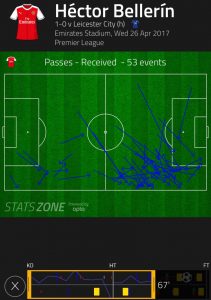
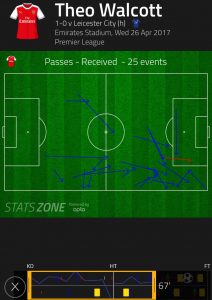
The problems on the right were compounded by what was going on infield.
Alexis Sanchez was more involved in play as Arsenal’s frontman in this formation than Olivier Giroud and Danny Welbeck have been, but this was not by design.
There was no space in behind Leicester’s defence for Alexis or Walcott, so the Chilean was forced to drop deep into already congested areas. He turned in an incredibly frustrating first half performance, with several attacks breaking down when the ball reached him.
Just before the break, he served a timely reminder that despite his frustrating display, he was Arsenal’s most likely source of providing something from nothing, when his long-range effort crashed off the bar.
Arsenal didn’t get a great deal of help down the left, either.
Kieran Gibbs was selected for just his fourth league start of the season. He only started three league games last season, with one of them coming on the wing during an injury crisis. Amid talks of the pursuit of Sead Kolasinac, you do wonder if Gibbs has a future at the club, despite his athleticism being a useful fit in the wing back system.
However, this system demands more than just athleticism on the left hand side.
Against Leicester, Gibbs offered very little constructive creative help on the ball and Leicester were content to let Arsenal circulate the ball towards him knowing he wouldn’t do anything with the ball that could hurt them.
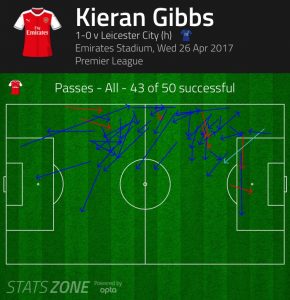
Sunday’s equalising hero, Monreal, was shifted to play as the left-sided centre back in the three. The success of Cesar Azpilicueta as a centre back in Chelsea’s own 3-4-2-1 system and the skills Monreal himself displayed when forced to play in the middle due to Arsenal’s injury crisis in 2014/15 suggested he would be able to slot in and do well.
He proved that on Wednesday night. Compare and contrast the progressive passes Monreal made to what Gibbs offered.
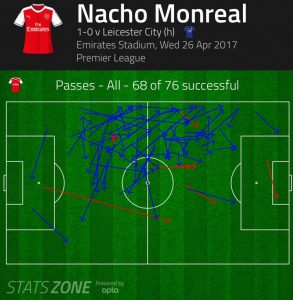
If one of the incumbent left backs is to make way for a new addition, Monreal’s versatility and superior ball skills, as again demonstrated against Leicester, may give him the edge over Gibbs in Wenger’s mind.
Another player whose future has come into question is Francis Coquelin.
He was given a chance in the new system, despite his poor 2017, to see how he’d adapt.
A player of his skillset is largely redundant against opposition like Leicester, as there is no opposition build-up play for him to break up. The 3-4-2-1 system dictates that he’s less important against the counter as there is an additional centreback behind him.
Regardless of system, he offers nothing on the ball that would trouble Leicester into thinking he’d be able to break their lines, so they consequently allowed him plenty of time and space on the ball, while marking the more dangerous players.

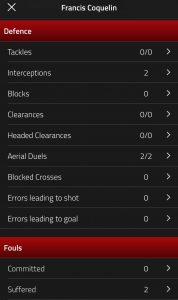
He padded his stats, completing 52 of 59 passes, but did little to trouble Leicester or help build play for Arsenal. Meanwhile, his defensive output which has earned him praise from his biggest fans, was not required.
He was a spare part for the 75 minutes he spent on the pitch.
For context, compare Coquelin’s output to Xhaka’s. It’s night and day
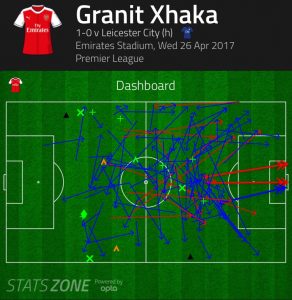
Having road-tested more players in the new system, Wenger can now make a more informed decision over who he trusts to take part in Sunday’s North London Derby.
That game and the remaining seven will help form a better picture of who will still be at Arsenal after the summer.
It’s still early days, but the new system looks ominous for some.

